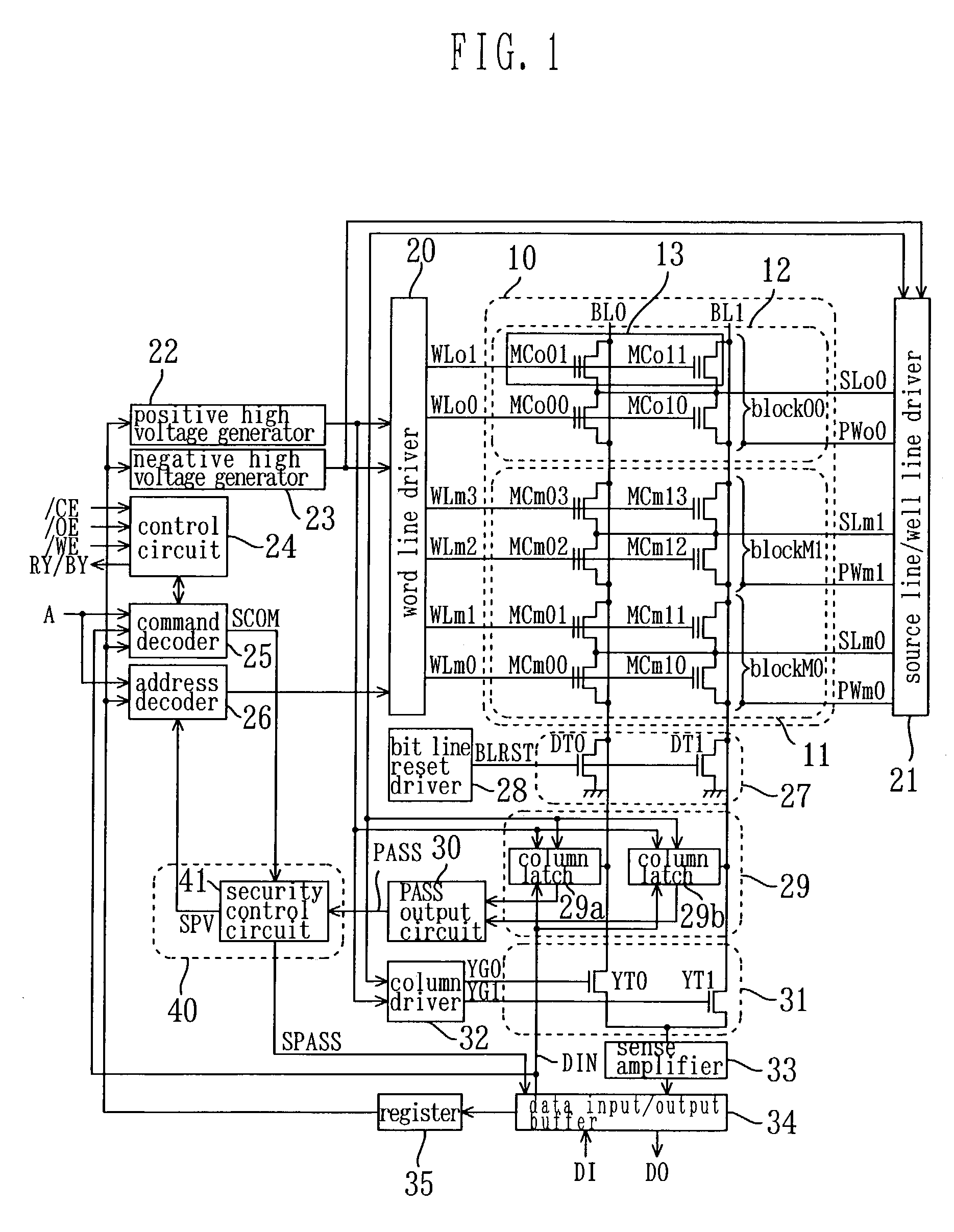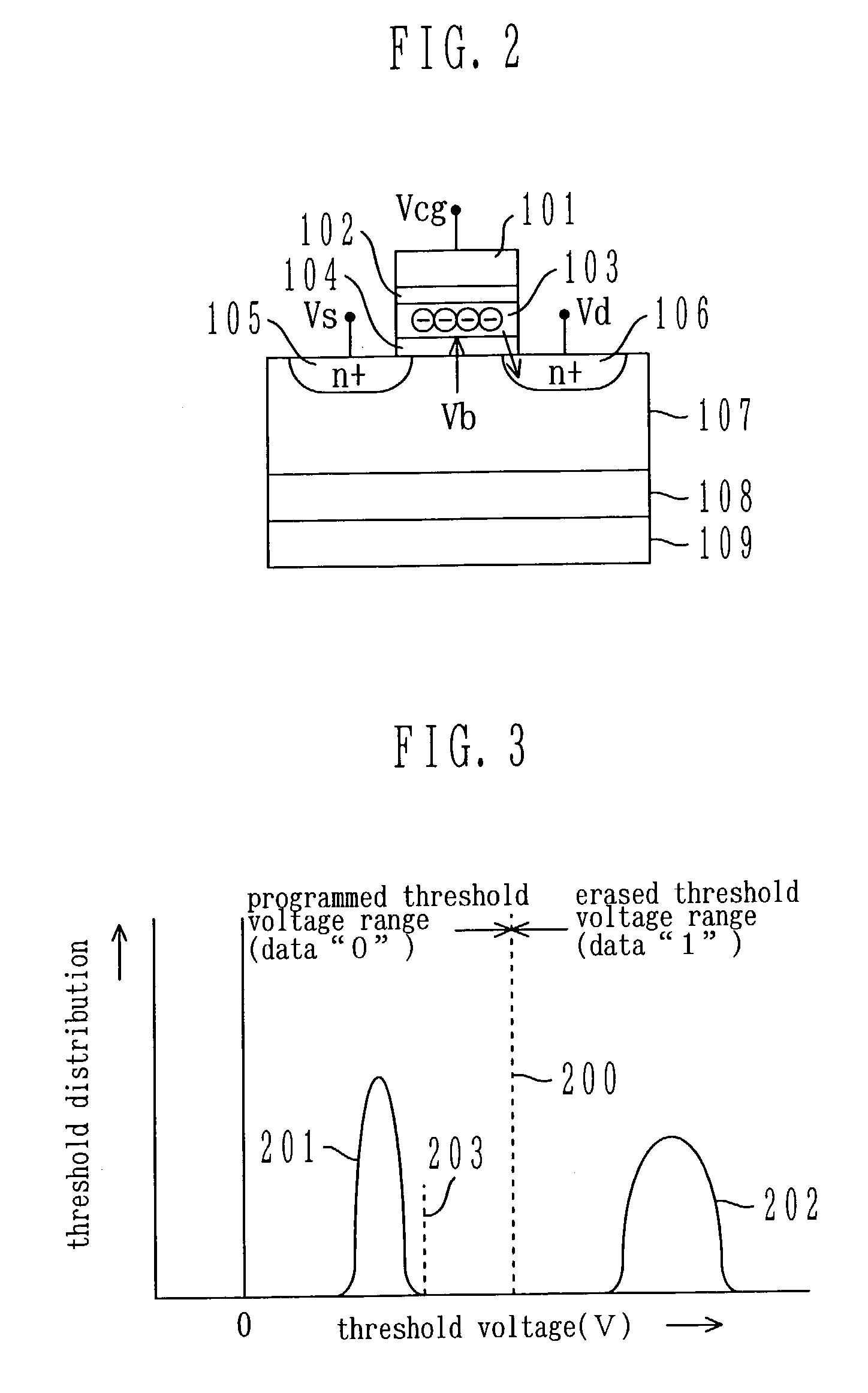Nonvolatile semiconductor memory device and method for providing security for the same
a technology of nonvolatile semiconductors and memory devices, applied in the direction of unauthorized memory use protection, instruments, computing, etc., can solve the problems of increasing the circuit size of a memory chip, affecting the security of classified information, and more conspicuous, so as to achieve the effect of further enhancing the function of providing security and enhancing the security
- Summary
- Abstract
- Description
- Claims
- Application Information
AI Technical Summary
Benefits of technology
Problems solved by technology
Method used
Image
Examples
first embodiment
[0048](First Embodiment)
[0049]Circuit Configuration
[0050]FIG. 1 is a circuit diagram showing the configuration of a nonvolatile semiconductor memory device (flash memory) according to a first embodiment. As shown in FIG. 1, the nonvolatile semiconductor memory device of the present embodiment includes: a memory cell array 10; and a peripheral circuit that operates when data is stored in the memory cell array 10 and when data is read out from the memory cell array 10.
[0051]The memory cell array 10 includes a plurality of memory cells MCm00 to MCm13 and memory cells MCo00 to MCo11 that are arranged in rows and columns. The memory cell array 10 is divided into a main region 11 that is open to a user and an optional region 12 that is not open to a user. In the main region 11, a plurality of memory cells MCm00 to MCm13 (normal memory cells) are arranged. On the other hand, in the optional region 12, a plurality of memory cells MCo00 to MCo11 are arranged, and a security function deactiva...
second embodiment
[0157](Second Embodiment)
[0158]In the verifying operation of the first embodiment, if all the latch data is data “1” at the start of the verifying operation, all the latch data after the verifying operation is data “1” irrespective of the data in the security function deactivation code stored in memory cells, and therefore, the PASS output circuit 30 is bound to output a high-level PASS signal as a result of the verifying operation. Accordingly, if a password in which all the data is “1” is stored in the column latch circuit 29, the security function can be deactivated irrespective of the data in the security function deactivation code. Therefore, a means for detecting that input latch data is prohibited data is provided in the second embodiment. As used herein, the prohibited data refers to, when all bits of input data are organized into a group or divided into two or more groups, input data having a group of bits in which all the data is “1”. In other words, the prohibited data re...
third embodiment
[0192](Third Embodiment)
[0193]In the first and second embodiments, when the security function deactivation command is inputted, a password for deactivating the security function is inputted by performing the page latching operation, and then the verifying operation is performed to whether or not the password is identical to the security function deactivation code. And if the password and the security function deactivation code are identical, the security function is deactivated. The security is ensured in this manner in the first and second embodiments. In the first and second embodiments, each of the settings of the address terminal A during the page latching operation, the address terminal A during the verifying operation, and the data input terminal DI during the verifying operation is an arbitrary setting “Don't Care”.
[0194]In the third embodiment, the nonvolatile semiconductor memory device is provided with a means for detecting that a specified address is inputted before the p...
PUM
 Login to View More
Login to View More Abstract
Description
Claims
Application Information
 Login to View More
Login to View More - R&D
- Intellectual Property
- Life Sciences
- Materials
- Tech Scout
- Unparalleled Data Quality
- Higher Quality Content
- 60% Fewer Hallucinations
Browse by: Latest US Patents, China's latest patents, Technical Efficacy Thesaurus, Application Domain, Technology Topic, Popular Technical Reports.
© 2025 PatSnap. All rights reserved.Legal|Privacy policy|Modern Slavery Act Transparency Statement|Sitemap|About US| Contact US: help@patsnap.com



